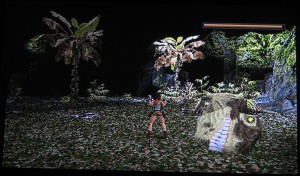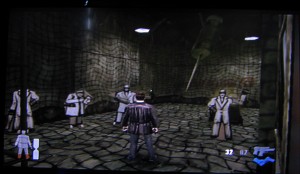110th played so far
Genre: Action
Platform: PC/Playstation/Sega Saturn
Year of Release: 1996
Developer: Core Design
Publisher: Eidos Interactive
Merry Christmas sports fans Pong and Beyond readers!
No, we are not doing a write-up on Christmas Day as we have been busy with presents, dinner and I have been personally been busy thinking of ways to teach combustion to a Year 9 class. The world really is our oyster when in this edition we take a look at the beginnings of the much-beloved Tomb Raider franchise.
This game holds some personal memories since it was in fact the first game that I was scared of! That’s right the T-Rex in level three used to scare the bejesus out of me… so much so that my mum actually played this game and got rather addicted. I bring this fact up to her everytime she gives me a dissaproving look when I have spent money on second-hand games rather than shirts for my placement. If it was not for the cheap multi-packs at M&S I would not have been able to buy a copy of UFC 2009 Undisputed. Merry Christmas y’all.
Our Thoughts
One of the reasons I remember this game, in the interest of full disclosure, was the existence of a patch called ‘Nude raider‘. It did to Lara Croft what the name implies, and was of course of immense interest to the group of 12 and 13 year olds I was a part of. Not that our parents knew, but we were… curious. (This of course only applied to the PC version, which I played back then. This time we played the PS1 installment) It sounds lame now – a texture swap and no details at all, but was just a bit too interesting at the time. Well the guys at Core Designs were asking for it and later gave the public what they wanted even though Lara Croft pre-Legends always looked a bit off.
Speaking of which, upon replaying this I was so dissapointed at how dated the game has become in terms of graphics and controls. The idea of a game like Tomb Raider not being able to make use of analog controls is completely ludicrous and as such it took us a while to get to grips with moving her around. Also the way they chose to set out the controls (with the jump function not occupying the six o’clock position) did lead to some confusion when I was suddenly being attacked by bears. Bears which I knew were coming since I both watched and actually the first few levels being played so many times when I was six. Animal lovers might want to avoid this game, the number of dead bears and wolves that are in the areas you explore when you’re done is surprisingly large.
The controls feel experimental – there is no set scheme yet, because everyone is still working that out, and it would take more time to establish what button is ok, jump or any of the other recurring functions you have in these games. I was happy we could play the tutorial first before we got into this… even though this tutorial didn’t cover shooting at all, leaving us confused for a bit. Shooting controls not mapped onto the shoulder buttons? That felt incredibly wrong as did an inability to aim… but you couldn’t do that with most action games of that era so it really is by-the-by. The truth is that if it wasn’t for the fact that we both had memories tied into this game we would not end up being as positive as we are about to be.
The thing is that despite the annoying controls and the really blocky graphics it is still rather compelling. The puzzles still feel smart and the large non-linear nature of a lot of the levels do feel like a breath of fresh air when you consider how linear a lot of action games are nowadays. The only huge obstacle to a truly enjoyable afternoon of relic snatching and Atlantis exploration can be resolved when I eventually pick up a copy of the Anniversary retweak. That’s the one thing games of this era do well that is lost nowadays. There isn’t a story to follow, no walking from point A to B. You can explore huge temples and caves with several secrets to find (and items there that help you) and you’re left to your own devices to figure out where to go. Nothing helpful, no hints or clues. Just walk around and see where you end up. There is a storyline involving mutants and relics but there is much more fun being had to finding the secret stashes of shotgun shells randomly hidden in apparently abandoned temples. Oh, I’m sure there is a story… it’s just not thrust in your face at every turn, making sure you remember it all. No room for our Metal Gear Solid-style fifteen minute cutscenes. It doesn’t all have to make sense or fit together, just be fun. The only thing you wish for there sometimes is that it wouldn’t take two minutes to get the game to toggle a switch for you, as you don’t get to the exact right spot to be allowed to do so.
Still, it is backed up with a score that works well to this day. The theme music itself is so nuanced and beautifully produced that it couldn’t help but bring back plenty of memories. The same goes with the incidental pieces of music which, although not used that often, still punctuate the gameplay rather nicely. You actually get a more rousing piece of music when you get closer to the end of the level, with its sort-of closing battles, as well as at some other tense moments. Because this suddenly becomes more obvious, it immediately gets you to sit up straight and pay attention.
The sound effects, at the same time, don’t work as well. This doesn’t always matter – probably shouldn’t – but some of them sounded too familiar and, to be honest, too fake. Too loud or too inappropriate – when climbing some tutorial gym class type objects, it sounded more like a hammer hitting wood when Lara moved from one side to the other. The one that really struck me was the near-orgasm she has every time you use a medi-pack. I don’t know if it’s heroin she is pumping to get herself through the expedition but it certainly is not baby aspirin.
Although this apparently wasn’t intended, Lara has become a major gaming sex symbol, and that’s something they had already set her up for in this game. The story goes that her creator, when trying to render the model, accidentally increased her breast size by some 20%. People saw this, and apparently that was the last bit that was missing to make her be a viable protagonist… I really do not know how much I believe that story but it’s a cute way to explain her proportions. It’s too good a story not to mention.
This is too influential a game to have not made the list. Tomb Raider is a classic, and Lara Croft possibly the first large video game celebrity. This game is just a little bit better in a remake, where controls and graphics are closer to modern standards.
Final Thoughts
Okay so we tend to be harsher on older games than newer games, we are aware of this and are sorry. There are some games (such as Super Metroid and DoDonPachi) that have a retro graphics style that can be appreciated whereas the gaming world’s early attempts at 3D will always fall slightly flatter since they have aged worse (yes Perfect Dark no matter how I like you the graphics will always make you look off).
Still, we had fun playing this both now and back then and in the end isn’t that what really matters?









